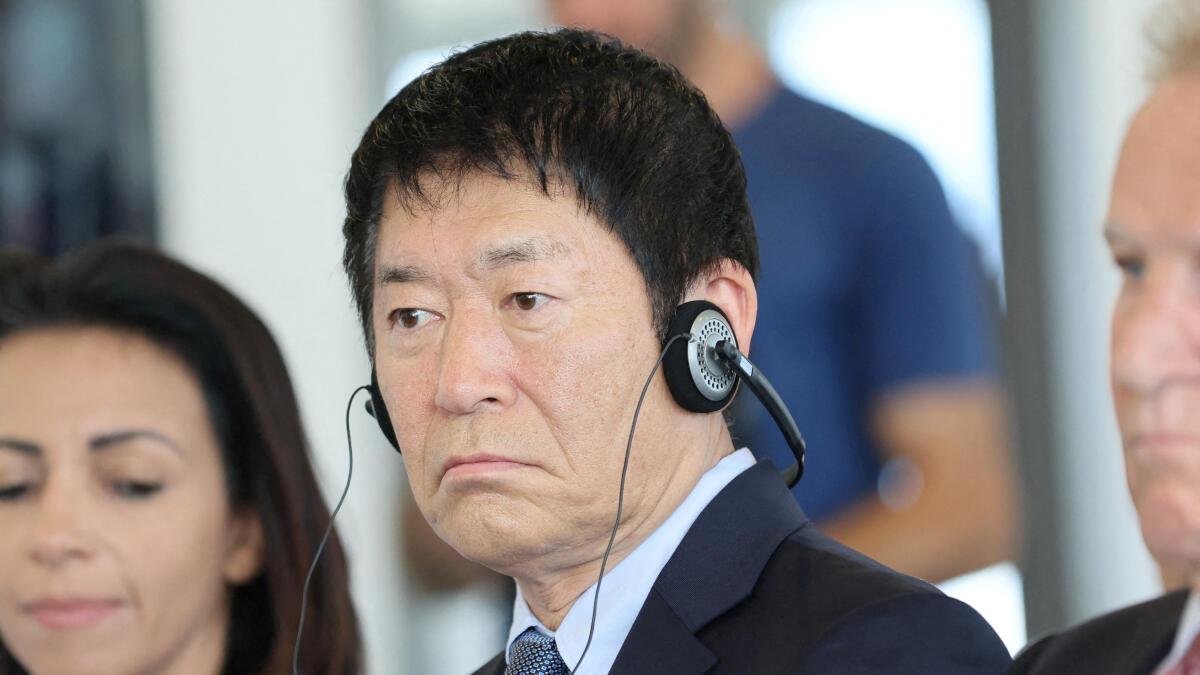Gymnastics’ governing body gave a muted reaction to Indonesia’s announcement that it would block Israeli athletes from competing at the upcoming world championships in Jakarta.
“The FIG takes note of the Indonesian government’s decision…


Gymnastics’ governing body gave a muted reaction to Indonesia’s announcement that it would block Israeli athletes from competing at the upcoming world championships in Jakarta.
“The FIG takes note of the Indonesian government’s decision…

Coronary artery ectasia (CAE) is defined as an abnormal dilatation – either diffuse or segmental – of a portion of a coronary artery to a diameter 1.5 times greater than that of an adjacent normal segment.1 Although CAE is…

The phase 3 ASTRUM-006 trial examining serplulimab (Hansizhuang) plus chemotherapy as neoadjuvant/adjuvant monotherapy treatment in patients with gastric cancer met its primary end point of event-free survival (EFS), according to an announcement from Shanghai Henlius Biotech, Inc.1
Additional data from the interim analysis conducted by an independent data monitoring committee (IDMC) showed that serplulimab plus chemotherapy elicited a pathologic complete response (pCR) rate that was threefold higher than that achieved with placebo plus chemotherapy and also significantly reduced the risk of recurrence. The combination was noted to have an acceptable toxicity profile, with no new safety signals reported.
Based on these findings, the IDMC has recommended early submission of a new drug application for serplulimab.
“Surgery is the cornerstone of gastric cancer treatment, and perioperative therapy is critical to long-term survival,” Professor Jiafu Ji, of Beijing Cancer Hospital, stated in a news release. “This study is the first to confirm the feasibility of replacing adjuvant chemotherapy with mono-immunotherapy in the postoperative setting. It not only opens a new path to consolidate surgical outcomes and reduce recurrence risk but also paves the way for innovation in clinical practice.”
Data from a study shared at the
The treatment-related adverse effects (TRAEs) that were most commonly experienced with the regimen were nausea, anorexia, thrombocytopenia, fatigue, and thyroid dysfunction. No TRAEs were grade 3 or higher in severity. The study authors concluded that the findings supported a place for immune-based neoadjuvant therapy in this setting.
The randomized, double-blind, phase 3 ASTRUM-005 study (NCT04063163) randomized patients with extensive-stage small cell lung cancer to serplulimab at 4.5 mg/kg on day 1 plus carboplatin at an area under the curve of 5 on day 1 and 100 mg/m2 of etoposide on days 1 to 3 Q3W for up to 4 cycles followed by maintenance serplulimab at 4.5 mg/kg Q3W or placebo plus the same chemotherapy regimen.3
Data shared during the 2025 ASCO Annual Meeting showed that those who received serplulimab (n = 389) experienced a median OS of 15.8 months (95% CI, 13.9-17.4) compared with 11.1 months (95% CI, 10.0-12.4) with placebo (n = 196), translating to a 40% reduction in the risk of death (HR, 0.60; 95% CI, 0.49-0.73; descriptive P < .001). The OS rates in the respective arms at 4 years were 21.9% (95% CI, 17.6%-26.6%) and 7.2% (95% CI, 3.8%-12.1%). The median progression-free survival with serplulimab was 5.8 months (95% CI, 5.6-6.9) vs 4.3 months (95% CI, 4.2-4.4), translating to a 53% reduction in the risk of disease progression or death (HR, 0.47; 95% CI, 0.38-0.57; descriptive P < .001).
Serplulimab plus chemotherapy elicited a confirmed objective response rate (ORR) of 68.9% (95% CI, 64.0%-73.5%), with a median duration of response (DOR) of 6.8 months (95% CI, 5.5-7.9). In the placebo arm, the confirmed ORR was 58.7% (95% CI, 51.4%-65.6%) and the median DOR was 4.2 months (95% CI, 3.1-4.2; HR for DOR was 0.45; 95% CI, 0.35-0.58; descriptive P < .001).
In June 2025, the Medicines and Healthcare Products Regulatory Agency of the
Serplulimab plus carboplatin and nab-paclitaxel (Abraxane) is also being evaluated in patients with previously untreated locally advanced or metastatic squamous non–small cell lung cancer. Data from the final analysis of the

The numbers are nothing short of staggering. Take Sam Altman, Open AI’s CEO. He reportedly wants 250 gigawatts of new electricity—equal to about half of Europe’s all-time peak load—to run gigantic new data centers in the U.S. and elsewhere worldwide by 2033.
Building or expanding power plants to generate that much electricity on Altman’s timetable indeed seems almost inconceivable. “What OpenAI is trying to do is absolutely historic,” says Varun Sivaram, Senior Fellow at the Council on Foreign Relations. The problem is, “there is no way today that our grids, with our power plants, can supply that energy to those projects, and it can’t possibly happen on the timescale that AI is trying to accomplish.”
Yet Sivaram believes Altman may be able to reach his goal of running multiple new data centers in a different way. Sivaram, in addition to his position at the CFR, is the founder and CEO of Emerald AI, a startup that launched in July. “I founded it directly to solve this problem,” he says—not just Altman’s problem specifically, but the larger problem of powering the data centers that all AI companies need. Several smart minds in tech like the odds of Sivaram’s company. It’s backed by Radical Ventures, Nvidia’s venture capital arm NVentures, other VCs, and heavy-hitter individuals including Google chief scientist Jeff Dean and Kleiner Perkins chairman John Doerr.
Emerald AI’s premise is that the electricity needed for AI data centers is largely there already. Even big new data centers would confront power shortages only occasionally. “The power grid is kind of like a superhighway that faces peak rush hour just a few hours per month,” Sivaram says. Similarly, in most places today the existing grid could handle a data center easily except in a few times of extreme demand.
Sivaram’s objective is to solve the problem of those rare high-demand moments the grid can’t handle. It isn’t all that difficult, at least in theory, he argues. Some jobs can be paused or slowed, he explains, like the training or fine-tuning of a large language model for academic research. Other jobs, like queries for an AI service used by millions of people, can’t be rescheduled but could be redirected to another data center where the local power grid is less stressed. Data centers would need to be flexible in this way less than 2% of the time, he says; Emerald AI is intended to help them do it by turning the theory to real-world action. The result, Sivaram says, would be profound: “If all AI data centers ran this way, we could achieve Sam Altman’s global goal today.”
A paper by Duke University scholars, published in February, reported a test of the concept and found it worked. Separately, Emerald AI and Oracle tried the concept on a hot day in Phoenix and found they could reduce power consumption in a way that didn’t degrade AI computation—“kind of having your cake and eating it too,” Sivaram says. That paper is under peer review.
No one knows if Altman’s 250-gigawatt plan will prove to be brilliant or folly. In these early days, Emerald AI’s future can’t be divined, as promising as it seems. What we know for sure is that great challenges bring forth unimagined innovations—and in the AI era, we should brace for plenty of them.

When I first heard a news story on the radio about the chikungunya virus, listening phonetically, I’ll admit that my mind went right to chickens and bird virus. Further context in the broadcast proved me wrong. It just goes to show, listening…